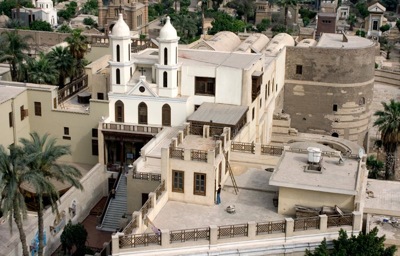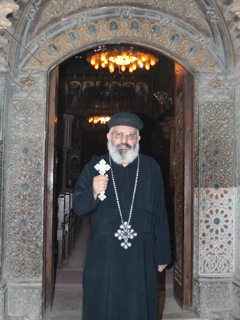Hanging Church

Panoramic view (QTVR 2.5 MB, Quickime Player required, download here)
The Hanging Church is also referred to as the Suspended Church or Al-Moallaqa. It is called the Hanging Church because it was built on the southern gate of the Roman Fortress. Logs of palm trees and layers of stones were constructed above the ruins of the Roman fortress to be used as a fundament. The Hanging Church is a unique church and has a wooden roof in the shape of Noah’s ark. From the 7th century to the 13th century, the Hanging Church served as the residence of the Coptic Patriarch. Al-Moallaqa has witnessed important elections and religious ceremonies.
The famous miracle of moving the Moqattam Mountain is closely related to al-Moallaqa. Al-Mu’izz, a Fatimid khaliph, asked Patriarch Abraham (975-978), the 62nd Patriarch, to prove the truth of a verse in the Bible. Al-Mu’izz asked Patriarch Abraham to move the Moqattam Mountain in order to prove the words of the gospel “If you have faith the size of a mustard seed, you shall say to this mountain: Remove from hence to yonder place, and it shall remove“ (Matthew 17-20).
After three days of praying and fasting in front of the painting of the Virgin Mary depicted on a column in al-Moallaqa, the Virgin Mary appeared to Patriarch Abraham in a vision and told him what to do. The painting of the Virgin Mary exists in the church to this day. Al-Mu’izz was convinced of the truth of the Christian belief and allowed the Coptic Church certain privileges.
There are three sanctuaries at the eastern side of the church, the one in the middle is dedicated to the Virgin Mary, the one to the left is named after St. George and the one to the right is named after John the Baptist. Inside the sanctuaries painted baldachins are placed above the altars.
The wooden screen is a unique piece of art and richly decorated with geometric patterns and crosses in ebony and ivory.
The wooden screen is crowned by precious icons, in the center the enthroned Jesus, on the left side the Virgin Mary, Archangel Gabriel and St. Peter, on the right side John the Baptist, Archangel Michael and St. Paul.
15 icons describe the life and torture of St. George, 7 icons give an insight into the life of John the Baptist.
The impressive pulpit of the Hanging Church is from the 5th century and rests on 15 gracile columns. On each side of the pulpit a cross is depicted above three steps symbolizing the three days during which Jesus Christ was in his tomb and his resurrection.
There is an icon of St. Mark on the southern wall of the main church (St. Mark is the first Patriarch of the Coptic Orthodox Church).
A total of 110 icons are kept in the Hanging Church, the oldest of which is the “Coptic Mona Lisa” dating back to the 8th century A.D. and representing Virgin Mary, Jesus Christ and John the Baptist. Numerous altar icons date back to the 18th century A.D.
There is a door at the south-eastern corner of the church leading to the oldest part of the building. This part has three sanctuaries at the eastern side. The one in the middle is called after St. Dimiana, the one to the left is named after St. Takla Hymanot (an Ethiopian saint), and the one to the right is named after St. Andrew.
Beside these sanctuaries is the baptistery.
There is also a fresco on the eastern wall of the chapel showing the Nativity (the birth of Christ) and the mid wife Salome, next to it a second fresco of 24 men of the apocalypse. Furthermore, on the first floor a church dedicated to St. Mark.
Fr. Jacob Soliman
Priest of the Hanging Church
